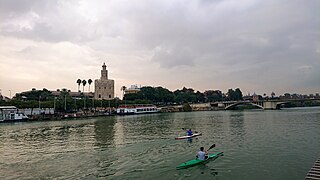
Córdoba, also called Cordova in English, is a city in Andalusia, southern Spain, and the capital of the province of Córdoba. It was a Roman settlement, taken over by the Visigoths, and then taken by Muslim armies in the eighth century. It became the capital of a Muslim emirate, and then of the Caliphate of Córdoba, which encompassed most of the Iberian Peninsula. During this period, it became a centre of education and learning, and by the 10th century had grown to possibly the largest city in Europe. It was recaptured by Christian forces in 1236, during the Reconquista.
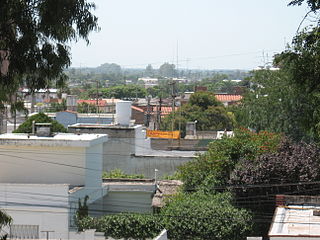
Alta Gracia is a city located in the north-centre of the province of Córdoba, Argentina. Its name means "High Grace". It is built upon the Sierras Chicas, in a region that the Comechingón Indians used to call Paravachasca. It has about 43,000 inhabitants.

Motril is a town and municipality on the Mediterranean coast in the province of Granada, Spain. It is the second largest town in the province, with a population of 60,368 as of 2016. The town is located near the Guadalfeo River and 69 km (43 mi) from Granada. The council of Motril includes the city of Motril and the neighbourhoods of El Varadero, Carchuna, Calahonda, Puntalón, Playa Granada, Las Ventillas, La Perla, La Garnatilla and La Chucha. The town is the capital of the region of the Coast of Granada.

Arcos de la Frontera is a town and municipality in the Sierra de Cádiz comarca, province of Cádiz, in Andalusia, Spain. It is located on the Northern, Western and Southern banks of the Guadalete river, which flows around three sides of the city under towering vertical cliffs, to Jerez and on to the Bay of Cádiz. The town commands a fine vista atop a sandstone ridge, from which the peak of San Cristóbal and the Guadalete Valley can be seen. The town gained its name by being the frontier of Spain's 13th century battle with the Moors.

The Alcázar de los Reyes Cristianos, also known as the Alcázar of Córdoba, is a medieval alcázar located in the historic centre of Córdoba, next to the Guadalquivir River and near the Grand Mosque. The Alcázar takes its name. The fortress served as one of the primary residences of Isabella I of Castile and Ferdinand II of Aragon.
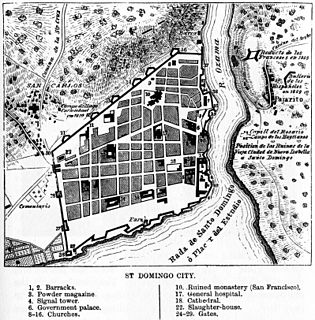
Ciudad Colonial is the historic central neighborhood of Santo Domingo and the oldest permanent European settlement of the Americas. It has been declared a World Heritage Site by UNESCO. It is also known as "Zona Colonial" or more colloquially as "La Zona". The Ciudad Colonial is located on the west bank of the Ozama River, which bisects the city. It covers 1.06 km2 (0.41 sq mi) bounded by a walled perimeter.

The Spanish missions in South America comprise a series of Jesuit Catholic religious outposts established by Spanish Catholics in order to spread the Christian doctrine among the local natives.

The Casco Antiguo is the city centre district of Seville, the capital of the Spanish region of Andalusia. It lies on the east bank of the Guadalquivir river. The Casco Antiguo borders the Macarena to the north, Nervión and San Pablo-Santa Justa to the east and the Distrito Sur to the south. Bridges across the Guadalquivir link the Casco Antiguo to Triana and Los Remedios on the Isla de La Cartuja.
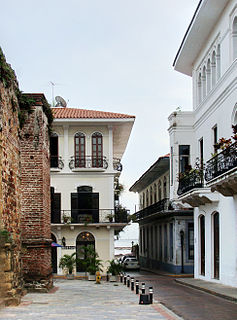
Casco Viejo, also known as Casco Antiguo or San Felipe, is the historic district of Panama City. Completed and settled in 1673, it was built following the near-total destruction of the original Panamá city, Panamá Viejo in 1671, when the latter was attacked by pirates. It was designated a World Heritage Site in 1997.

The Cathedral of Córdoba is the central church of the Roman Catholic Archdiocese of Córdoba, Argentina, and the oldest church in continuous service in Argentina.
Seville, the capital of the region of Andalusia in Spain, has 11 districts, further divided into 108 neighbourhoods.
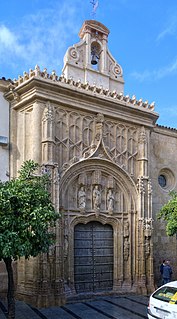
San Sebastián Hospital is a 16th-century building on Calle Torrijos in Córdoba, Spain. It is situated in the historic centre, just opposite the west front of the Mosque–Cathedral of Córdoba. Founded in 1363 in Alcayceria, it was moved in the early 16th century. Built to a design by Hernán Ruiz, el Viejo, construction on the current building occurred during the period of 1512-16. The building served as a hospital (1516-1816); a home for mothers and infants (1816-1961); and currently houses the Palace of Congresses and Exhibitions, as well as the Office of Tourism.

The Chapel of San Bartolomé is a funerary chapel in the historic centre of Córdoba, Spain. It is dated between 1390 and 1410. Richly decorated, it is one of the city's finest examples of Mudéjar art.
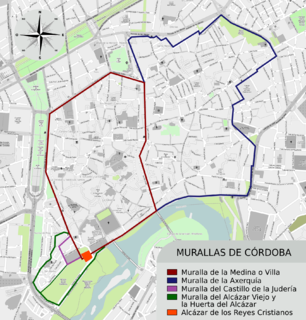
The Roman Walls which once surrounded Córdoba, Spain, were built after the Romans captured the city in 206 BC, making it part of the Roman Republic. The walls now form part of the historic centre of Córdoba, a UNESCO World Heritage site.

Santa María Magdalena is a church in Córdoba, Spain, built in the Mudejar style. It forms part of the Historic centre of Córdoba, a UNESCO World Heritage site.


